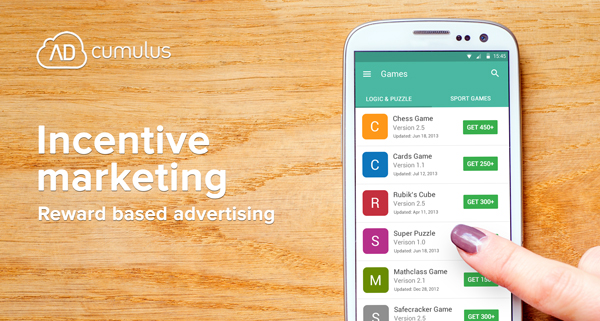Online marketing blog
Read about the latest industry trends and AdCumulus specials.
Incentive marketing – a lesson in monetizing non-paying customers
By on 27. October 2015.

Reaching customers is always a challenge. Most monetization comes from advertising through banner ads or native ads. Approximately 2% to 6% users actually pay for purchasing an app. However, there is a way for app developers to monetize the rest of their non-paying users, and the answer lies in incentive marketing.
What is incentive marketing?
Incentive marketing is based on offering users an incentive for performing a specific action. It also helps app developers to monetize their user base. Basically, we are talking about pages that appear within the app and enable end users to get rewards or incentives in exchange for completing some action.
In most cases, completing actions in order to earn rewards requires no financial commitment from users. On the one hand, publishers earn a commission for every completed action, and on the other, earned credits can be redeemed for virtual goods from a publisher. Incentive marketing can be based on CPA, CPS, CPL or CPM pricing model.
How does it work?
Let’s take the game industry as an example. Incentive marketing can be used for completing a specific action, like:
• downloading another app from the same game developer
• taking part in a survey
• signing up for a new service
• making a small purchase
• simply watching an ad in exchange for getting extra lives, levels or coins in games
• pretty much anything users would be seeking to obtain within the app
Besides typical incentive based action like points or cash, there are also other forms such as incentivized registrations. Paying for virtual goods, perks and services makes incentive marketing ideal for the game industry. Furthermore, you can combine different platforms in incentive marketing. Users can, for example, make calls from mobile phones in exchange for virtual currency or get access to paid content.
Offer walls
Offer walls as one example of incentive marketing are a great way for increasing EPC (Earnings per click). An offer wall is a landing page which shows multiple products. So instead of driving traffic to one offer, the traffic is driven to an offer wall with multiple choice of offers and the chances for sale automatically increase. For example, offer walls can be used for giving a discount on products. Whether you are a media buyer, affiliate or a product owner, you can use offer walls to increase your EPC.
In comparison with traditional ads
Incentive marketing provides a great advertising situation for users. They can spend money, watch the advertisement and be rewarded for it or simply ignore the ad and continue with their experience. And the best part is that the advertising is delivered directly to the end user, mostly in the form of a landing page.
There is no need for users to do an extra action in order to click on a banner. They remain within the application environment and have the option to get or buy an item they are interested in, which makes incentive marketing quite a user-friendly experience and less intrusive than traditional ads.
Deeper user engagement
Incentive marketing also enables advertisers to incentivize the audience to the desired degree, such as clicking through a website or visiting a brand page, which leads to deeper user engagement. By providing users with exactly what they need, advertisers are on a good way to increase the conversion rate. If used wisely, advertisers can easily monetize non-paying users and have 10 to 100 times higher performance than usual ads.
All talk, no game?
There is, however, a downside of incentive marketing. The biggest problem is the fact that users often do only what is necessary to gain incentive and it stops at that. They simply do not continue to engage with an application over time. So it is important to have good content that will keep users engaged. With the right dose of creativity, incentive marketing is a great way for reaching your audience.





Comments